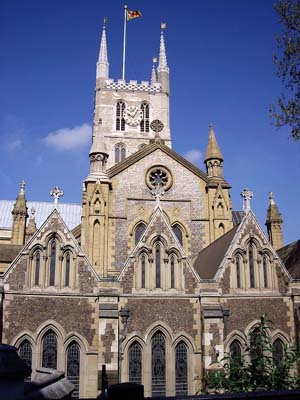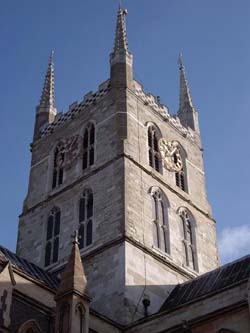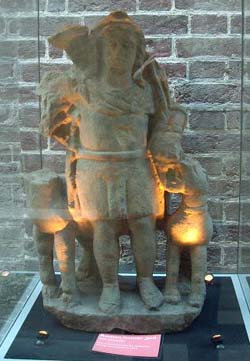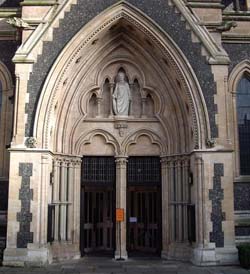Southwark Cathedral
by Sean McLachlan
 For centuries, the boroughs of London on
the South Bank of the Thames were considered a no-go area for
respectable people, being a den of thieves, prostitutes,
gambling, and (horror or horrors!) the theatre. Of course, these
activities actually attracted a lot of so-called
respectable people from the wealthier districts north of the
river, who tended to visit in large, well-armed groups. For centuries, the boroughs of London on
the South Bank of the Thames were considered a no-go area for
respectable people, being a den of thieves, prostitutes,
gambling, and (horror or horrors!) the theatre. Of course, these
activities actually attracted a lot of so-called
respectable people from the wealthier districts north of the
river, who tended to visit in large, well-armed groups.
But for centuries there has been a more positive influence here.
Southwark Cathedral was once one of the only refuges of sanity
and beauty in the stink and chaos of Borough of Southwark, and is
now a religious and tourist center in a newly revived and much
more prosperous South Bank.
The cathedral, officially the Cathedral and Collegiate Church of
St. Saviour and St. Mary Overie, Southwark, is similar to many of
London's older churches in that nobody is sure just when it was
founded. Local legend says that St. Swithun, Bishop of
Winchester, set up a college of priests here sometime in the
middle of the ninth century. The Domesday Book, a meticulous
census done by the Normans to see just how much they got when
they conquered England, records that a monastery existed on the
spot when the Normans arrived in 1066. The book records that the
monastery had its own wharf and conducted trade along the
river.
The present church got its life as St. Mary Overie, meaning
"over the river", in 1106, and was home to monks of the
Augustinian order. The Augustinians served the local populace
with a hospital named after St. Thomas of Canterbury. Amazingly,
St. Thomas hospital still exists, although it has been moved west
to Lambeth.
The church immediately became important due
to its relation with the Bishop of Winchester, who lived in a
palace only a short walk away. One wall of this palace exists to
its original height and incorporates an attractive rose window.
Besides tending to the faithful, the bishop had several other
duties, including running the local prison, the famous
"Clink", burned to the ground in a riot in 1780 and now
the site of a cheesy tourist trap "museum". He also
oversaw the local businesses, which included a large number of
brothels, whose ladies of the night were called "Winchester
Geese."
 The oldest parts of the present church date to 1260,
the product of a rebuild after a fire destroyed the original
church. The architects took their inspiration from the French
Gothic, and this the oldest Gothic building in the city. Over the
years, more fires and gradual decay led to many additions and
changes, including the installation of an ornate altar screen in
1520 separating the choir from the retro-choir. The oldest parts of the present church date to 1260,
the product of a rebuild after a fire destroyed the original
church. The architects took their inspiration from the French
Gothic, and this the oldest Gothic building in the city. Over the
years, more fires and gradual decay led to many additions and
changes, including the installation of an ornate altar screen in
1520 separating the choir from the retro-choir.
During the Dissolution, Henry VIII's grab for church property did
not spare St. Mary Overie, and it lost much of its property and
became a parish church called St. Saviour, Southwark. While Henry
VIII tried to make England Protestant, his daughter Queen Mary
tried to revert back to Catholicism. During her reign Stephen
Gardiner was Bishop of Winchester and tried heretics in the
church. Most of these unfortunates were preachers who spoke out
against Queen Mary or Catholicism, and Gardiner sent seven men to
their deaths.
Throughout its history the cathedral had a rather ambiguous
relationship with the borough. It tried to set a moral example,
yet licensed a large number of brothels. It preached law and
order, but many thieves claimed sanctuary within its walls. No
matter what side of an issue it came down upon, however,
Southwark Cathedral was always a driving force in the borough and
a center for the community. The church's most major
remodel came in 1890 with the construction of a new nave. The
builders kept the soaring French Gothic style and the nave is in
such perfect harmony with the rest of the building that many
visitors assume it's medieval. The modern age has so many
examples of inappropriate or just plain ugly additions to
beautiful old buildings that Southwark Cathedral comes as a
welcome exception.
The nave heralded a new beginning for the church, which had
declined into disrepair in the previous century. In 1905 it
became the Cathedral and Collegiate Church of St Saviour and St
Mary Overie, seat of the bishopric of Southwark.
 The newest addition to this historic
building is an annex, opened in 2001 by Nelson Mandela,
containing meeting rooms and a gift shop stocked with a good
selection of books. Of interest to visitors is a display from the
archaeological excavations that cleared the way for the annex to
be built. Many original features are left as the archaeologists
found them, including a first century Roman road, the early
twelfth century foundations of the Norman priory, and part of a
slightly later chapter house and archway. There's also a stone
coffin still in place from the thirteenth century and a Delft
pottery kiln from the seventeenth century. The newest addition to this historic
building is an annex, opened in 2001 by Nelson Mandela,
containing meeting rooms and a gift shop stocked with a good
selection of books. Of interest to visitors is a display from the
archaeological excavations that cleared the way for the annex to
be built. Many original features are left as the archaeologists
found them, including a first century Roman road, the early
twelfth century foundations of the Norman priory, and part of a
slightly later chapter house and archway. There's also a stone
coffin still in place from the thirteenth century and a Delft
pottery kiln from the seventeenth century.
One notable find from a separate excavation beneath the choir was
a statue of a Roman hunter god, hinting that this was a site of
worship well before the advent of Christianity. The statue was
found at the bottom of a well, so perhaps it comes from the time
when the old gods were being overthrown for the new one. It's on
display in the annex. Archaeologists also found a portion of a
Roman villa and some of the paving is still on the floor of the
choir.
Today Southwark cathedral is an active church with a special
ministry for those suffering from HIV and AIDS. There are daily
services, and a choral Evensong most evenings. Builders of the
French Gothic not only knew how to construct dramatic interiors,
they also understood acoustics, and the Evensong is a
transcendent musical experience.
Visiting the cathedral is easy, since it's right off the Thames
Path, a popular pedestrian walk along renovated neighborhoods
next to the river. The outside of the church is very distinctive
with its flint cobbles. This unusual construction is popular in
areas of England where flint is plentiful, especially
Hertfordshire, and churches built with a flint facing are called
"puddingstone churches." Inside, the most
impressive features are the lofty 19th-century nave and the
16th-century choir screen, dating to 1520. Passing by this
screen, which reaches almost to the ceiling, enter the retro
choir at the very end of the church. This part dates to the
thirteenth century and is a large open area that seems roomier
than it is due to the slim columns upholding graceful arches.
When the church fell on hard times in the 16th century, this area
was rented out and used as a pig sty.
 One side chapel is called the Harvard Chapel and is
dedicated to John Harvard, the son of a butcher who was baptized
here in 1607 and went on to found the famous university. Don't
miss the nearby gisant, a recumbent stone effigy of an emaciated
corpse in a shroud. In past centuries, people didn't cover up
the ugly face of death and gisants can be seen in churches
throughout Western Europe. One side chapel is called the Harvard Chapel and is
dedicated to John Harvard, the son of a butcher who was baptized
here in 1607 and went on to found the famous university. Don't
miss the nearby gisant, a recumbent stone effigy of an emaciated
corpse in a shroud. In past centuries, people didn't cover up
the ugly face of death and gisants can be seen in churches
throughout Western Europe.
There's also a monument to Shakespeare, who lived in this parish
but is buried in his home town of Stratford-upon-Avon. Behind it
is a splendid stained glass window showing scenes from some of
his plays. Another influential writer who actually does rest here
is John Gower, poet laureate to Richard II and Henry IV and
dubbed "the first English poet" since he often wrote in
English at a time when his contemporaries favored Latin and
French. There are also monuments to Edmund Shakespeare, William's
brother, and dramatists John Fletcher and Philip Massinger.
A sharp-eyed visitor will find many more interesting details in a
careful tour of the cathedral, too many to list here. The
Southwark Cathedral makes a perfect stop on the Thames Path,
which passes right by the building. The South Bank is getting new
life as businesses and professionals move into the area to take
advantage of its cheaper rents. The neighborhoods still get a bit
rough a few blocks south of the river, but the area along the
Thames Path is quite safe, so leave your sword and brace of
pistols at home.
Visitor's Information
Entrance to the Cathedral is free although a voluntary donation is welcome.
The cathedral offers a drop-in tour on Friday at 11am and 1pm, and Sunday at 1pm. The cost per person is £3 and under 16s go free. Due to services and events, it's recommended that you contact the cathedral first to check that the tour is available on the day. For group visits and tours, contact the Visits and Tours Officer on 020 7367 6734.
There's a small fee to take photos within the
cathedral. Services are open to everyone. Services and Evensong
dates may vary due to special events, so check the website or
call ahead before you go to get the latest schedule. The
Cathedral is open Mon.-Fri., 7:30 a.m.-6 p.m.; Sat.-Sun. and Bank
Holidays 8:30 a.m.-6 p.m.
More Information:
We regret that we no longer have the resources to maintain up-to-date links and/or hours and pricing details for the various sites and attractions listed on this website. For more information about the location(s) listed above, please use your favorite search engine or visit Wikipedia.
Article and photos © 2007 Sean McLachlan
| 